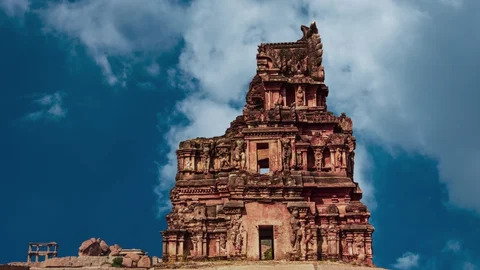Hampi – Karnataka

Address
Hampi Temple, Hosapete, Vijayanagara district, Karnataka, India
Diety
Shiva
Introduction
Hampi or Hampe, also referred to as the Group of Monuments at Hampi, is a UNESCO World Heritage Site located in east-central Karnataka, India. It is a pilgrimage centre of the Hindu religion. Hampi was the capital of the Vijayanagara Empire in the 14th century. Chronicles left by Persian and European travellers, particularly the Portuguese, say that Hampi was a prosperous, wealthy and grand city near the Tungabhadra River, with numerous temples, farms and trading markets. By 1500 CE, Hampi-Vijayanagara was the world’s second-largest medieval-era city after Beijing, and probably India’s richest at that time, attracting traders from Persia and Portugal. The Vijayanagara Empire was defeated by a coalition of Muslim sultanates; its capital was conquered, pillaged and destroyed by sultanate armies in 1565, after which Hampi remained in ruins. Located in Karnataka near the modern-era city of Hosapete, Hampi’s ruins are spread over 4,100 hectares (16 sq mi) and it has been described by UNESCO as an “austere, grandiose site” of more than 1,600 surviving remains of the last great Hindu kingdom in South India that includes “forts, riverside features, royal and sacred complexes, temples, shrines, pillared halls, mandapas, memorial structures, water structures and others”. Hampi predates the Vijayanagara Empire; there is evidence of Ashokan epigraphy, and it is mentioned in the Ramayana and the Puranas of Hinduism as Pampaa Devi Tirtha Kshetra. Hampi continues to be an important religious centre, housing the Virupaksha Temple, an active Adi Shankara-linked monastery and various monuments belonging to the old city.
Puranic Significance
The synonym Hampi—traditionally known as Pampa-kshetra, Kishkindha-kshetra or Bhaskara-kshetra is derived from Pampa, another name of the goddess Parvati in Hindu theology. According to mythology, the maiden Parvati (who is a reincarnation of Shiva’s previous wife, Sati) resolves to marry the loner ascetic Shiva. Her parents learn of her desire and discourage her, but she pursues her desire. Shiva is lost in yogic meditation, oblivious to the world; Parvati appeals to the gods for help to awaken him and gain his attention. Indra sends the god Kama the Hindu god of desire, erotic love, attraction, and affection to awake Shiva from meditation. Kama reaches Shiva and shoots an arrow of desire. Shiva opens his third eye in his forehead and burns Kama to ashes. Parvati does not lose her hope or her resolve to win over Shiva; she begins to live like him and engage in the same activities asceticism, yogin and tapasya awakening him and attracting his interest. Shiva meets Parvati in disguised form and tries to discourage her, telling her Shiva’s weaknesses and personality problems. Parvati refuses to listen and insists in her resolve. Shiva finally accepts her and they get married. Kama was later brought back to life after the marriage of Shiva and Parvati According to Sthala Purana, Parvati (Pampa) pursued her ascetic, yogini lifestyle on Hemakuta Hill, now a part of Hampi, to win and bring ascetic Shiva back into householder life. Shiva is also called Pampapati (meaning “husband of Pampa”). The river near the Hemakuta Hill came to be known as Pampa river. The Sanskrit word Pampa morphed into the Kannada word Hampa and the place Parvati pursued Shiva came to be known as Hampe or Hampi. The site was an early medieval era pilgrimage place known as Pampakshetra. Its fame came from the Kishkindha chapters of the Hindu epic Ramayana, where Rama and Lakshmana meet Hanuman, Sugriva and the monkey army in their search for kidnapped Sita. The Hampi area has many close resemblances to the place described in the epic. The regional tradition believes that it is that place mentioned in the Ramayana, attracting pilgrims. It was brought to light by an engineer named colonel Colin Mackenzie during the 1800s.
Century/Period/Age
1000 to 2000
Managed By
UNESCO World Heritage Centre
Nearest Bus Station
Badami, Aihole
Nearest Railway Station
Hosapete
Nearest Airport
Jindal




